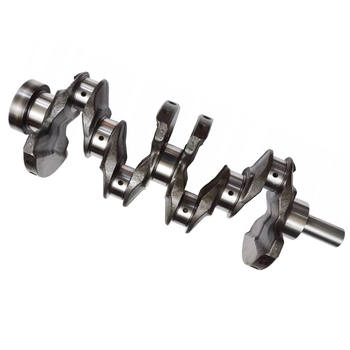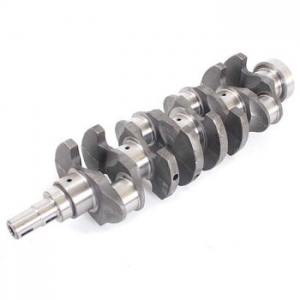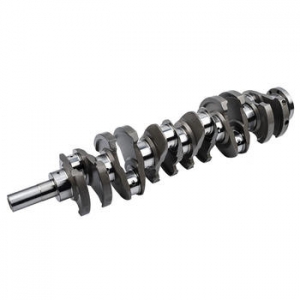Beyond Vibration: An Engineer\'s Guide to Diagnosing Crankshaft Fatigue and Extending Engine Life
In the intricate world of mechanical engineering, few components bear as much dynamic stress and cyclical loading as the crankshaft. It's the very heart of an engine, converting linear piston motion into rotational power. When it comes to engine health, vibration analysis often serves as the first line of defense, a crucial indicator of potential issues. However, to be honest, relying solely on vibration data can be akin to listening to a patient's cough without ever taking an X-ray. While indicative, it rarely tells the whole story, especially when it comes to the insidious progression of crankshaft fatigue. This article aims to guide engineers beyond the superficial hum, delving into advanced methodologies for diagnosing crankshaft fatigue and, critically, extending engine life.
Beyond the Hum: Why Standard Vibration Analysis Isn't Enough for Crankshaft Health
Vibration analysis is undeniably powerful. It can detect imbalances, misalignments, bearing wear, and even some forms of gear damage with remarkable precision. Changes in frequency spectra, amplitude trends, and phase relationships provide invaluable insights into an engine's operational state. But here's the rub: by the time crankshaft fatigue manifests as a discernible vibration signature, the damage is often already severe, potentially irreversible, and catastrophic failure may be imminent. Interestingly enough, fatigue cracks typically initiate and propagate at a microscopic level long before they generate enough mechanical looseness or mass imbalance to significantly alter the engine's macroscopic vibration characteristics.
Consider this: a hairline crack, perhaps just a few micrometers deep, might be slowly growing from a stress concentration point – a fillet radius, an oil hole, or a surface imperfection. This crack doesn't necessarily cause a noticeable change in the engine's overall vibration profile until it reaches a critical size, significantly compromising the crankshaft's structural integrity. At that point, the engine might suddenly exhibit severe knocking, excessive vibration, or a complete breakdown. This reactive approach, where diagnosis occurs post-significant damage, is precisely what we aim to move beyond. Our goal, as engineers, must be proactive detection and prevention, not just reactive repair.

The Silent Killer: Unraveling Crankshaft Fatigue Mechanisms and Their Impact on Engine Life
Crankshaft fatigue isn't a single event; it's a cumulative process. It begins with microscopic damage at the material level, often due to repeated stress cycles that are individually below the material's yield strength but collectively erode its structural integrity. The primary mechanisms at play include:
- High Cycle Fatigue (HCF): This is the most common form in crankshafts, resulting from millions of load cycles at relatively low stress amplitudes. Every combustion event, every piston stroke, every revolution of the crankshaft contributes to these cycles.
- Low Cycle Fatigue (LCF): Occurs under fewer load cycles but at higher stress amplitudes, often associated with transient events like engine startup/shutdown, misfires, or severe overload conditions.
- Corrosion Fatigue: The synergistic effect of a corrosive environment and cyclic stress, which can accelerate crack initiation and propagation significantly. This is particularly relevant in marine engines or those operating in harsh conditions.
- Fretting Fatigue: Damage caused by small-amplitude oscillatory sliding between two surfaces under normal load, often seen at bearing journals or flange connections, leading to surface wear and crack initiation.
The impact of these mechanisms on engine life is profound. A crankshaft is designed with a finite fatigue life, but this life can be drastically reduced by operational factors, manufacturing defects, or inadequate maintenance. A fatigue crack, once initiated, will propagate under continued cyclic loading. As it grows, the remaining cross-sectional area of the crankshaft reduces, leading to an increase in local stress intensity at the crack tip. This accelerates propagation, eventually leading to catastrophic brittle fracture, often without warning. In my experience, understanding these underlying mechanisms is the first critical step in developing effective diagnostic and preventive strategies. Without this foundational knowledge, any diagnostic effort is merely guesswork.
Precision Diagnostics: Advanced Engineering Approaches to Identifying Crankshaft Fatigue
Moving beyond basic vibration analysis requires a suite of sophisticated techniques that can detect the early signs of material degradation and crack initiation. These methods often require specialized equipment and expertise, but their value in preventing costly failures and extending engine life is immeasurable.
Non-Destructive Testing (NDT) for Surface and Sub-Surface Flaws
NDT methods are paramount for inspecting crankshafts without causing damage. They are particularly effective during planned maintenance shutdowns or for in-situ inspections.
- Magnetic Particle Inspection (MPI): This is a widely used method for detecting surface and near-surface cracks in ferromagnetic materials like steel crankshafts. A magnetic field is applied, and fine magnetic particles are dusted over the surface. Cracks cause flux leakage, attracting the particles and making the flaw visible. It's excellent for detecting fatigue cracks originating from the surface, such as at fillet radii or oil holes.
- Liquid Penetrant Testing (LPT): Suitable for detecting surface-breaking flaws on non-porous materials, including non-ferrous crankshafts or specific areas of steel crankshafts. A liquid penetrant seeps into surface discontinuities, and after removing excess, a developer draws the penetrant out, revealing the flaw.
- Eddy Current Testing (ECT): This electromagnetic NDT method is highly sensitive to surface and near-surface cracks, material thickness changes, and conductivity variations. An alternating current coil induces eddy currents in the crankshaft. Flaws disrupt these currents, altering the coil's impedance, which is then measured. ECT can be automated and is excellent for rapid scanning of critical areas.
- Ultrasonic Testing (UT): A powerful technique for detecting both surface and sub-surface flaws. High-frequency sound waves are transmitted into the crankshaft, and reflections (echoes) from internal discontinuities are analyzed. UT can determine the size, shape, and orientation of cracks, making it invaluable for assessing the severity of detected flaws. Phased array ultrasonic testing (PAUT) offers even greater precision and imaging capabilities.
Advanced Monitoring Techniques for Early Warning
While NDT provides snapshots, continuous or semi-continuous monitoring offers dynamic insights into the engine's health.
- Oil Analysis and Debris Monitoring: A routine oil analysis program can reveal the presence of wear metals (e.g., iron, chromium, nickel) that indicate abnormal component wear. More advanced techniques include ferrography, which analyzes the size, shape, and concentration of wear particles in the oil, providing clues about the wear mechanism (e.g., abrasive wear, fatigue spalling). The presence of specific particle morphologies can strongly suggest incipient fatigue failure in bearings or journals.
- Acoustic Emission (AE) Monitoring: This passive NDT technique detects transient elastic waves generated by rapid localized stress redistribution in a material. As a fatigue crack propagates, it emits high-frequency stress waves that can be detected by piezoelectric sensors mounted on the engine block or crankshaft itself. AE monitoring can provide real-time indication of crack growth, offering a significant advantage over methods that only detect existing flaws. It's worth noting that distinguishing AE signals from background engine noise requires sophisticated signal processing.
- Strain Gauging and Stress Analysis: For critical applications or during engine development, strategically placed strain gauges on the crankshaft can directly measure dynamic stresses. By comparing measured stresses against fatigue limits, engineers can assess the remaining fatigue life and identify areas of unexpectedly high stress concentrations. This is often used in conjunction with Finite Element Analysis (FEA) to validate design and predict stress distributions.

Proactive Preservation: Strategies for Extending Engine Life and Mitigating Crankshaft Fatigue Risk
Diagnosing fatigue is only half the battle; the ultimate goal is to extend engine life and prevent failures. This requires a multi-faceted approach encompassing design, material selection, manufacturing quality, and operational practices.
Design and Material Considerations
- Optimized Geometry: Fatigue cracks often initiate at stress concentration points. Careful design of fillet radii, oil holes, and transitions can significantly reduce localized stresses. Many experts agree that smooth transitions and generous radii are critical for fatigue resistance.
- Material Selection: High-strength steels (e.g., forged alloy steels like 42CrMo4, 34CrNiMo6) with good fatigue properties are essential. The microstructure, cleanliness (absence of inclusions), and grain flow achieved through forging processes are also vital.
- Surface Treatments: Processes like nitriding, shot peening, or induction hardening create a compressive residual stress layer on the surface, which significantly improves fatigue resistance by hindering crack initiation.
Manufacturing Quality and Post-Processing
The quality of manufacturing directly impacts fatigue life. Surface finish, absence of machining marks, and proper heat treatment are paramount. Any surface defect can act as a stress concentrator and a potential crack initiation site. Strict quality control during forging, machining, and grinding is non-negotiable.
Operational Practices and Maintenance Regimes
Even a perfectly designed and manufactured crankshaft can fail prematurely if subjected to improper operational conditions.
- Load Management: Avoiding sustained overloading, excessive transient loads, and rapid temperature changes can significantly extend crankshaft life.
- Lubrication and Cooling: Adequate lubrication prevents wear and reduces friction, while effective cooling manages thermal stresses. Proper oil viscosity, cleanliness, and regular oil changes are critical.
- Alignment and Balancing: Regular checks for engine alignment and crankshaft balancing are essential to minimize bending stresses and dynamic loads that can contribute to fatigue.
- Predictive Maintenance Programs: Implementing a robust predictive maintenance program incorporating the advanced diagnostic techniques discussed earlier (NDT, oil analysis, AE monitoring) allows for timely intervention before critical failure. This shifts the paradigm from reactive repairs to proactive asset management.
Real-World Insights: Applying Advanced Diagnostics to Prevent Crankshaft Failure and Extend Engine Life
Let's consider a hypothetical but common scenario. A large industrial diesel engine, powering a critical generator, has been operating for years with routine vibration monitoring showing no significant anomalies. However, our company, specializing in advanced diagnostics, is called in for a comprehensive health check as part of a planned overhaul.
During the inspection, standard visual checks reveal nothing. However, applying magnetic particle inspection to the crankshaft's fillet radii and oil holes, we discover a faint, almost imperceptible indication at the junction of the crankpin and web on cylinder #3. This is a classic stress concentration point. Subsequent ultrasonic testing confirms a sub-surface crack, approximately 5mm deep, propagating from the fillet. This crack was too small to generate a noticeable vibration signature, yet it was well on its way to catastrophic failure.
Without this proactive, beyond-vibration approach, the engine would likely have continued operating until the crack reached a critical size, leading to a sudden, unscheduled shutdown and potentially extensive damage to the engine block and surrounding machinery. The cost of such a failure – including lost production, emergency repairs, and potential safety hazards – would far outweigh the investment in advanced diagnostics. This experience highlights the critical role of specialized NDT and the engineer's keen eye in identifying hidden threats.
Another example involves continuous oil analysis and ferrography. In a fleet of marine engines, our monitoring program detected an unusual increase in fine, laminar wear particles in the oil from one particular engine, even though vibration levels remained within acceptable limits. This type of particle morphology is often indicative of incipient fatigue spalling from rolling element bearings or even surface fatigue on journals. Further investigation, including borescope inspection and targeted NDT during the next port call, confirmed early signs of surface fatigue on a main bearing journal. This early detection allowed for a planned bearing replacement, preventing a much larger issue and extending the overall operational life of the engine without interruption.

The Future of Engine Reliability: Embracing a Holistic Approach to Crankshaft Health Beyond Vibration
The journey to truly reliable engine operation extends far beyond merely listening to the engine's hum. While vibration analysis remains a fundamental diagnostic tool, it must be complemented by a deeper understanding of material fatigue and the application of advanced diagnostic techniques. An engineer's guide to crankshaft health is not just about identifying problems; it's about anticipating them, preventing them, and ultimately maximizing the operational life and safety of these critical machines.
The integration of NDT, advanced oil analysis, acoustic emission monitoring, and rigorous operational practices forms a holistic strategy for managing crankshaft fatigue. This proactive approach not only averts catastrophic failures but also optimizes maintenance schedules, reduces downtime, and significantly lowers lifetime operating costs. As engines become more powerful and operate under increasingly demanding conditions, the imperative to look "beyond vibration" becomes ever more critical. Are we truly doing everything we can to ensure the longevity of our most vital mechanical assets? The answer lies in embracing these advanced engineering principles.
For more detailed information, please visit our official website:Crankshaft fatigue diagnosis
About the author: Dr. Anya Sharma is a seasoned mechanical engineer with over 15 years of experience specializing in rotating machinery diagnostics and asset integrity management. Her expertise lies in non-destructive testing, fatigue analysis, and predictive maintenance strategies for critical engine components. Anya is passionate about extending the operational life of industrial machinery and preventing catastrophic failures through advanced engineering solutions.
 Trusted Crankshaft Manufacturi
Trusted Crankshaft Manufacturi
 Trusted Crankshaft Supplier |
Trusted Crankshaft Supplier |
 Trusted Crankshaft Manufacture
Trusted Crankshaft Manufacture
 Trusted Crankshaft company Man
Trusted Crankshaft company Man
